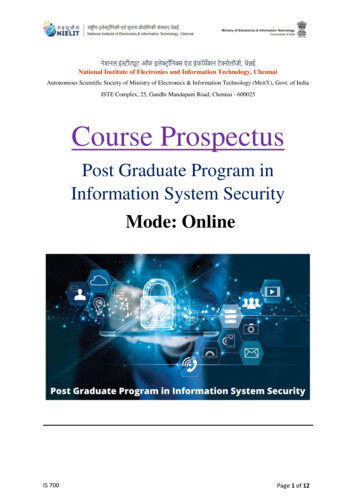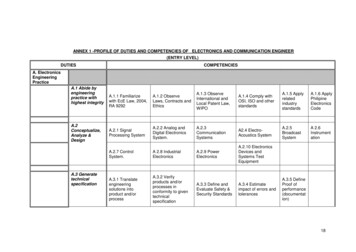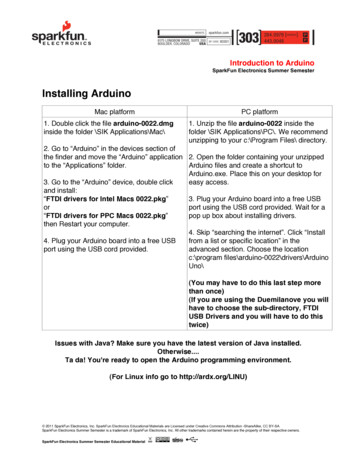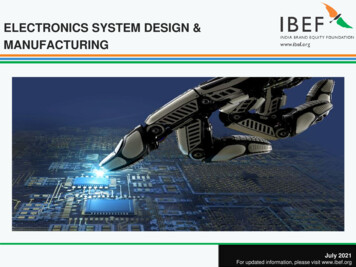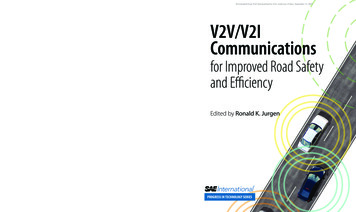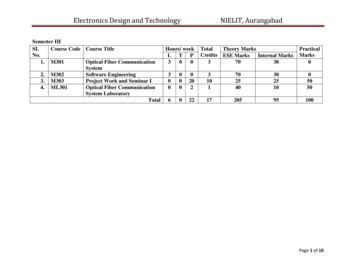
Transcription
Electronics Design and TechnologySemester IIISI.Course Code Course TitleHours/ weekNo.L T P1. M301Optical Fiber Communication300System2. M302Software Engineering3003. M303Project Work and Seminar I00 204. ML301Optical Fiber Communication002System LaboratoryTotal 60 22NIELIT, AurangabadTotalTheory MarksCredits ESE MarksInternal 595100Page 1 of 10
Electronics Design and TechnologyNIELIT, AurangabadThird SemesterCourse CodeCourse TitleCreditsPre-requisutesM301Optical Fiber Communication System3-0-0:3NilObjective To learn the basic elements of optical fiber transmission link, fiber modes configurationsand structures. To understand the different kind of losses, signal distortion in optical wave guides andother signal degradation factors. Design optimization of SM fibers, RI profile and cut-offwavelength. To learn the various optical source materials, LED structures, quantum efficiency, Laserdiodes and different fiber amplifiers. To learn the fiber optical receivers such as PIN APD diodes, noise performance in photodetector, receiver operation and configuration. To learn fiber slicing and connectors, noise effects on system performance, operationalprinciples WDM and solutions. To be able to design transmitter and receiver circuit of the optical fiber link. Should get aware of the criteria of selection of optical fiber cable in an optical link Should get the knowledge about difference in video, voice and data transmitter system. Should get the concepts of other optoelectronics techniques like acousto-optics, electrooptics and Integrated Optics.Syllabus: Introduction, Opto electronics sources and Detections, Opto Electronics Instructions,Laser system, Electro optics and non liner optics effects, Optical communication systemsand design, Optical sensors and systemsCourse Outcome After finishing the course student will become familiar with all components of opticalfiber system like sources, detector and optical fiber Students will become knowledgeable about the working principal of above devices. Student will get knowledge about the construction mechanism and selection criteria ofOptical fiber cables. The student will be able to design transmitter circuits, receiver circuit and selection ofoptical fiber cable for a given conditions of the optical fiber link. Will have the knowledge about selection of optical fiber and optical fiber cable fordifferent type of an optical link, with having application for voice, video or datatransmission.Page 2 of 10
Electronics Design and TechnologyNIELIT, Aurangabad Will have knowledge of other optoelectronics techniques like acousto-optic acoustooptic, electro optics and Integrated Optics.TEXT BOOKS:1. J. Senior, "Optical Communication, Principles and Practice", Prentice Hall of India,1994.2. Fiber optics by R. P. Khare, oxford university pressREFERENCES:1. Gerd Keiser, "Optical Fiber Communication" McGraw -Hill International, Singapore, 3rded., 20002. J.Gower, "Optical Communication System", Prentice Hall of India, 20013. Fundamentals of Photonics 2nd ed., Saleh and Teich, (John Wiley & Sons, inc., 2007).4. Fiber Optic Communication Systems – Govind P. Agarwal, John Wiley, 3rd Edition,20045. Photonics: Optical Electronics in Modern Communications by Yariv, Pochi yehCourse Plan:Modules (Theory)Module 1: Introduction:Ray theory of transmission, propagation of light in anisotropicmedia, light propagation in wave guides. Fiber optics-history,types of fibers, characteristics of optical fiber, fabrication.Fibersplicing-mechanical and fusion splicing and testing of opticalfibers.Laser Devices:Historical introduction, emission and absorption of radiation,spontaneous and stimulated emission, population inversion,optical feedback, the laser resonator.Module 2: Optical sources and detectorsLight emitting diodes: LED of different colors, Materials usedfor emission of lightLED power and efficiency, irradiance, LEDstructures, Characteristics of LED.LASER: Injection laser diodes, Basic Homojunction laser,Double hetro-junction laser.Laser system, power supplies for laser, Various gas, solid statesemiconductor lasers and their properties, application in brief.Detectors: Optical detection principle, Absorption, Quantumefficiency, Responsivity, Long-wavelength cutoff, Rise timeand bandwidth. Photodiodes without internal gain- The PNphotodiode, PIN photodiode- construction, speed of response.Photodiodes with internal gain- APD, silicon reach throughavalanche photodiode. Photo detector Noise-Noise Sources,Signal-to-Noise Ratio, Noise-Equivalent Power.No. ofHours%ESE marks7251025Page 3 of 10
Electronics Design and TechnologyModule 3: Optical communication system and designOptical fibers and other components for fiber opticcommunication, fiber optic communication system. Systemconsideration- Wavelength, Photo detector, Optical source,optical fiber, Losses. Link power budget and rise timeconsideration, Transmitter & receiver circuits. WDM- workingprinciple, Optical Amplifiers-Erbium Doped Fiber Amplifier,Semiconductor optical amplifier, Photonic switching,SONET/SDH.Module 4Electro optics and non-linear optics effects:Design of A.O modulators and deflectors. Electro- optic effectsPockels and Kerr effects: change in refractive index in KDPcrystal. Design of electro optional modulators, switching,multiplexers and other devices. Integrated optical circuits.Nonlinear Effects: Effective Length and Area, StimulatedRaman Scattering (SRS), Stimulated Brillouin Scattering (SBS),Self-Phase Modulation (SPM), Cross-Phase Modulation, FourWave Mixing.Module 5:Opto-electronic instructions:Laser interferometry and application to metrology and testing,Holography and holographic interferometry, speckle techniques.Digital speckle pattern interferometer, Laser gyro and Dopplervelocimetry, OTDR, LIDAR applications,NIELIT, Aurangabad1020820510Page 4 of 10
Electronics Design and TechnologyCourse CodeCourse TitleCreditsPre-requisitesNIELIT, AurangabadM302Software Engineering3-0-0:3NilObjective Understand basic SW engineering methods and practices, and their appropriateapplication. Understand u of software process models such as the waterfall and evolutionarymodels. Role of project management including planning, scheduling and, risk management. Discuss data models, object models, context models and behavioral models. Understand of different software architectural styles and Process frame work. Understand of implementation issues such as modularity and coding standards.Syllabus: System Analysis and Design: Overview of System Analysis & Design , BusinessSystem Concept, System Development Life Cycle ,System Design – ProblemPartitioning, Top-Down And Bottom-Up design ;Decision tree, Testing – Levels ofTesting, Integration Testing, Test case Specification, Reliability Assessment,Validation & Verification Metrics, Monitoring & Control. Software ProjectManagement – Project Scheduling, Staffing, Software Configuration Management,Quality Assurance, Project Monitoring and Mobile application securityCourse Outcome Knowledge of basic SW engineering methods and practices, and their appropriateapplication. Describe software engineering layered technology and Process frame work. A general understanding of software process models such as the waterfall andevolutionary models. Understanding of software requirements and the SRS documents. Understanding of the role of project management including planning, scheduling, riskmanagement, etc. Describe data models, object models, context models and behavioral models. Understanding of different software architectural styles. Understanding of implementation issues such as modularity and coding standardshould get the concepts of other optoelectronics techniques like acoustic-optics, electrooptics and Integrated Optics.TEXT BOOKS:1. 1. R. G. Pressman – Software Engineering, TMHPage 5 of 10
Electronics Design and TechnologyNIELIT, AurangabadREFERENCES:1. IEEE Standards on Software Engineering. Kane, Software Defect Prevention, SPD2. Behforooz, Software Engineering Fundamentals, OUP3. Ghezzi, Software Engineering, PHI4. Object Oriented & Classical Software Engineering(Fifth Edition), SCHACH,TMH5. Vans Vlet, Software Engineering, SPD6. Uma, Essentials of Software Engineering, Jaico7. Sommerville, Ian – Software Engineering, Pearson Education8. Benmenachen, Software Quality, VikasCourse Plan:Modules (Theory)Module 1: System Analysis and Design : Overview ofSystem Analysis & Design , Business System Concept,System Development Life Cycle, Waterfall Model , SpiralModel, Feasibility Analysis, Technical Feasibility, CostBenefit Analysis, COCOMO model.Module 2: Design related issues: System RequirementSpecification – DFD, Data Dictionary, ER diagram,Process Organization & Interactions. System Design –Problem Partitioning, Top-Down And Bottop-Up design;Decision tree, decision table and structured English;Functional vs. Object- Oriented approach.Module 3: Coding & Documentation: Coding &Documentation – Structured Programming, OOProgramming, Information Hiding, Reuse, SystemDocumentation. Testing – Levels of Testing, IntegrationTesting, Test case Specification, Reliability Assessment,Validation & Verification Metrics, Monitoring & Control.Module 4: User Interface : Module Introduction,Objectives of Usability, How to Approach Usability,Designing with Usability in mind, Measuring Usability,Guidelines for User Interface Design, User InterfaceElements.Module 5: Software Project Management & Softwaresecurity : Software Project Management – ProjectScheduling, Staffing, Software Configuration Management,Quality Assurance, Project Monitoring , Software securitylife cycle Software quality attributes Security requirementgathering principles and guidelines A case Study (Mobileapplication security) Mobile application security Malwareclassification and analysis Module 4 (Design and testingfor security, best practices) Secure software designprinciples Static analysis techniques Security testing (blackNo. of Hours%ESEmarks10258251025610715Page 6 of 10
Electronics Design and TechnologyNIELIT, Aurangabadbox and white boxPage 7 of 10
Electronics Design and TechnologyCourse CodeCourse TitleCreditsPre-requisitesNIELIT, AurangabadM303Project Work and Seminar I0-0-10:10NilObjective: To improve the professional competency and research aptitude by touching the areaswhich otherwise not covered by theory or laboratory classes. The project work aims todevelop the work practice in students to apply theoretical and practical tools/techniquesto solve real life problems related to industry and current research.Syllabus:The project work can be a design project/experimental project and/or computersimulation project on any of the topics in electronics design related topics. The project work isallotted individually on different topics. The students shall be encouraged to do their projectwork in the parent institute itself. If found essential, they may be permitted to continue theirproject outside the parent institute, subject to the conditions of M.Tech regulations. Departmentwill constitute an Evaluation Committee to review the project work. The Evaluation committeeshall be headed by the head of the department with other faculty members in the area of theproject.The student is required to undertake the Project Work and Seminar I during the thirdsemester and the same is continued in the 4th semester (Phase 2). Phase 1 consist of preliminarythesis work, two reviews of the work and the submission of preliminary report. First reviewwould highlight the topic, objectives, methodology and expected results. Second reviewevaluates the progress of the work, preliminary report and scope of the work which is to becompleted in the 4th semester.Course Outcome:After successful completion of the project phase I, students should be able to: Formulate a research problem and perform literature review Systematically carrying out a research and write technical reportsEvaluation/ Assessment:Guide (25 marks)Evaluation Committee (25 marks)Page 8 of 10
Electronics Design and TechnologyCourse CodeCourse TitleCreditsPre-requisutesNIELIT, AurangabadML301Optical Fiber Communication System Laboratory0-0-1: 1Objective: To Train students practically in the field of optical communication so that they canrelate theory with elements of design and applications. To understand different kinds of losses, signal attenuation in optical fibers. To make students familiarize with different types of connectors. To make student familiar with different splicing techniques. To train students by giving practical exposure on fiber optic splicing machinefollowing proper methods for good splicing. To make students understand the use of OTDR and study various losses in the opticalfiber. To make students interpret the trace in OTDR.Syllabus: Different types of fiber cables, connectors, LED and Photo detectors. Establishmentof analog and digital link, intensity modulation techniques, attenuation loss,Numerical Aperture, bending loss, OTDR.Course Outcome: Students will be able to classify different types of fiber optic cable and theircomponents. Students will be able to identify different types of fiber optic connectors. Students will get knowledge about different types of LED and Photodetectors. Students will be able to calculate losses. Students will learn proper methods to be followed for optical fiber splicing andjoining. Students will be able to handle OTDR and interpret the traces plotted in OTDR.Course Plan:SI. No.1.2.3.4.Practicals (at least 10 nos)Demonstration of different types of fiber cables andconnectors.To study the characteristics of given LED and Photodetector.To Establish Analog and Digital link using opticalfiber cable.Study of Intensity Modulation Technique usingAnalog input signal.No. ofHours% ESE marks210210210210Page 9 of 10
Electronics Design and Technology5.6.7.8.9.10.To measure propagation or attenuation loss in opticalfiber.To Study Bending Loss in fiber optic communication.To measure the Numerical Aperture (N.A.) of thefiber optic cable.To establish Fiber optic voice link.To study the Optical time Domain reflectometer andinterpret the trace generated in OTDR.To Study the Fiber Optic Splicing and Joining.NIELIT, Aurangabad210210210210210210Page 10 of 10
ML301 Optical Fiber Communication System Laboratory 0 0 2 1 40 10 50 Total 6 0 22 17 205 95 100 . Electronics Design and Technology NIELIT, Aurangabad . Gerd Keiser, "Optical Fiber Communication" McGraw -Hill International, Singapore, 3rd ed., 2000 2. J.Gower, "Optical Communication System", Prentice Hall of India, 2001
